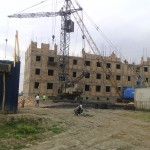Resource-sharing technologies in construction of low-roof buildings
16.02.2018
 Annotation: This article presents advantages of such a dwelling including: lower cost, the shortest duration of construction, simplified technology, the possibility of dismantling the house and transporting it to a new location, increasing if necessary the area of the house, resource saving and other factors
Annotation: This article presents advantages of such a dwelling including: lower cost, the shortest duration of construction, simplified technology, the possibility of dismantling the house and transporting it to a new location, increasing if necessary the area of the house, resource saving and other factorsOne of the key features of the current stage of development of housing construction is an increase in the requirements for low-rise residential buildings in the field of comfort and resource saving. The use of new technologies and non-traditional types of housing is a fundamental direction in the future residential development. At the same time, in many respects alternative types of dwellings: prefabricated, mobile, transforming, solar and other types of houses are not inferior to traditional ones. The advantages of such a dwelling include: lower cost, the shortest duration of construction, simplified technology, the possibility of dismantling the house and transporting it to a new location, increasing if necessary the area of the house, resource saving and other factors.
Economic feasibility is one of the conditions for choosing housing not only for wealthy citizens, but for people with an average and below average income. The rapid increase in energy prices, tariffs for electricity and transport, put forward the task of improving heat-shielding properties and reducing the weight of residential buildings.
Requirements for increasing the thermal protection of buildings and structures, the main energy consumers, is an important object of state regulation in most countries of the world. These requirements are also considered from the point of view of environmental protection, rational use of non-renewable natural resources and reduction of the influence of the "greenhouse" effect and reduction of emissions of carbon dioxide and other harmful substances into the atmosphere.
Increasing importance is the reduced total cost of housing, including both a one-time capital costs, and the cost of operation for the entire life of the house. In this regard, the most promising architectural and construction systems of low-rise buildings should be effective both with regard to the thermal protection properties of structures and the consumption of basic building materials.
Simultaneously with the appearance of new materials, new building systems should also be developed: monolithic with the left formwork and effective insulation, frame made of various materials, including wood, metal and concrete. These architecturally-building systems should be distinguished by technological flexibility, a lot of variants of possible architectural and planning solutions and design solutions, the availability of performance, which will make them competitive in the modern market of house-building products.
With the scientific analysis, the established practice of building prefabricated housing revealed that when building a house of load-bearing polystyrene panels, saving energy resources (per 1 sq. M. Of total area) in comparison with the brick option in production is two times, during construction - three times, exploitation-five times. Cost per 1 sq. M. m in the construction of "turnkey" of the panels is almost half as much as in the construction of traditional materials. Costs are lower: due to lower cost of enclosing structures, reduction of construction time, light foundations and lack of necessity to use lifting equipment. The same applies to frame houses built using ecopan technology - the Canadian technology of frame-panel construction. Frame houses have high heat-saving properties - which puts them on a par with buildings built in alternative ways. The panel thickness of 164 mm for thermal conductivity is equal to a bricklaying 2.5 m thick. Due to the use of panel technology, houses can be erected in three months. The artistic expressiveness of such a house is clearly visible both outside and inside. All is thought over to trifles, with various facade architectural variations from framing of windows from polystyrene to decorative cornice.
Thus, among the most important parameters of a low-rise residential house is the consumption of thermal energy. It represents a significant share in the total energy consumption of buildings, which can be significantly reduced. Reduction of energy consumption is achieved by saving other resources, in particular, water, by reducing the amount of waste and household waste. As a result, energy-efficient buildings become resource-saving. At the same time, saving resources and volume of waste means reducing the burden on the environment, reducing the weight of the ecological backpack. The use of secondary resources is one of the aspects of economic and environmental activity, consisting in the reuse of waste products of any kind that allows not only to increase its economic efficiency, but also to reduce the level of pollution of the natural environment and its impact on social processes.